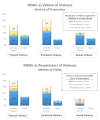Is Intimate Partner and Client Violence Associated with Condomless Anal Intercourse and HIV Among Male Sex Workers in Lima, Peru?
- PMID: 26880321
- PMCID: PMC4985504
- DOI: 10.1007/s10461-016-1327-8
Is Intimate Partner and Client Violence Associated with Condomless Anal Intercourse and HIV Among Male Sex Workers in Lima, Peru?
Abstract
Violence experience can increase HIV risk behaviors; however, literature is scarce on violence among male sex workers (MSWs) globally. In 2014, 210 Peruvian MSWs (median age 24.9) were interviewed about their experience of physical, emotional, and sexual violence and condom use with non-paying intimate partners and clients and were tested for HIV. Multivariable models examined relationships between violence in the past 6 months, condomless anal intercourse (CLAI) in the past 3 months and HIV infection. HIV infection (24 %), CLAI (43 %), being a violence victim (42 %) and perpetrator (39 %) were common. In separate multivariable models, being a violence victim [adjusted prevalence ratio aPR = 1.49 (95 % CI 1.09-2.03)] and perpetrator [aPR = 1.39 (1.03-1.87)] were associated with CLAI. Further, being a victim [aPR = 1.65 (1.04-2.62)] was associated with HIV infection. Violence, which was significantly associated with CLAI and HIV infection, is common among Peruvian MSWs, reinforcing the importance of violence awareness and prevention as HIV risk-reduction strategies.
Keywords: Client violence; HIV; Intimate partner violence; Lima, Peru; Male sex work.
Figures

Similar articles
-
Inconsistent Condom Use Among Female Sex Workers: Partner-specific Influences of Substance Use, Violence, and Condom Coercion.AIDS Behav. 2020 Mar;24(3):762-774. doi: 10.1007/s10461-019-02569-7. AIDS Behav. 2020. PMID: 31254189 Free PMC article.
-
Intimate Partner Violence Against Transgender Women: Prevalence and Correlates in Lima, Peru (2016-2018).AIDS Behav. 2020 Jun;24(6):1743-1751. doi: 10.1007/s10461-019-02728-w. AIDS Behav. 2020. PMID: 31720954 Free PMC article.
-
Associations Between Violence and HIV Risk Behaviors Differ by Perpetrator Among Russian Sex Workers.AIDS Behav. 2020 Mar;24(3):812-822. doi: 10.1007/s10461-019-02668-5. AIDS Behav. 2020. PMID: 31531737
-
Forced sexual initiation, sexual intimate partner violence and HIV risk in women: a global review of the literature.AIDS Behav. 2013 Mar;17(3):832-47. doi: 10.1007/s10461-012-0361-4. AIDS Behav. 2013. PMID: 23143750 Free PMC article. Review.
-
Condomless Sex With Partners and Clients Among Female Sex Workers in Iran: A Systematic Review and Meta-Analysis.J Assoc Nurses AIDS Care. 2022 Jan-Feb 01;33(1):63-77. doi: 10.1097/JNC.0000000000000305. J Assoc Nurses AIDS Care. 2022. PMID: 34939989
Cited by
-
"I Couldn't Afford to Resist": Condom Negotiations Between Male Sex Workers and Male Clients in Mombasa, Kenya.AIDS Behav. 2020 Mar;24(3):925-937. doi: 10.1007/s10461-019-02598-2. AIDS Behav. 2020. PMID: 31321637 Free PMC article.
-
Social Capital Moderates the Relationship Between Stigma and Sexual Risk Among Male Sex Workers in the US Northeast.AIDS Behav. 2020 Jan;24(1):29-38. doi: 10.1007/s10461-019-02692-5. AIDS Behav. 2020. PMID: 31587116 Free PMC article.
-
Perceived risk and condomless sex practice with commercial and non-commercial sexual partners of male migrant sex workers in London, UK.F1000Res. 2023 Oct 19;10:1033. doi: 10.12688/f1000research.73248.2. eCollection 2021. F1000Res. 2023. PMID: 37928318 Free PMC article.
-
Epidemiology of gonorrhoea: a global perspective.Sex Health. 2019 Sep;16(5):401-411. doi: 10.1071/SH19061. Sex Health. 2019. PMID: 31505159 Free PMC article. Review.
-
Inconsistent Condom Use Among Female Sex Workers: Partner-specific Influences of Substance Use, Violence, and Condom Coercion.AIDS Behav. 2020 Mar;24(3):762-774. doi: 10.1007/s10461-019-02569-7. AIDS Behav. 2020. PMID: 31254189 Free PMC article.
References
-
- ANÁLISIS DE LA SITUACIÓN EPIDEMIOLÓGICA DEL VIH/SIDA EN EL PERÚ, 2013. Minist Salud Direccion Gen Epidemiol . 2013 Nov
-
- Ugarte Ubillúz O, Arce Rodríguez M, et al. Informe nacional sobre los progresos realizados en la aplicación del UNGASS. Período: enero 2008-diciembre 2009. [cited 2014 Dec 5];Perú. 2010 Available from: http://www.bvcooperacion.pe/biblioteca/handle/123456789/6409.
-
- Ministerio de Salud (MINSA) Perú. Lima, Peru: MINSA, ONUSIDA; 2012. Apr, Programa Conjunto de las Naciones Unidas sobre el VIH/SIDA (ONUSIDA). Informe Nacional sobre los Progresos Realizados en el País. Periodo enero 2011 - diciembre 2012.
MeSH terms
Grants and funding
LinkOut - more resources
Full Text Sources
Other Literature Sources
Medical
Miscellaneous

